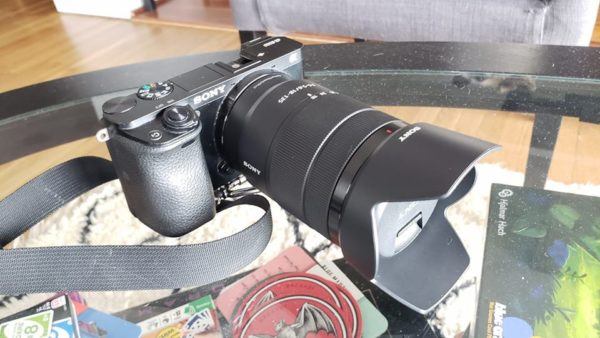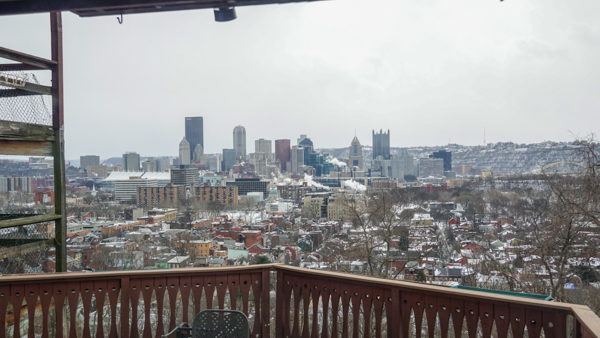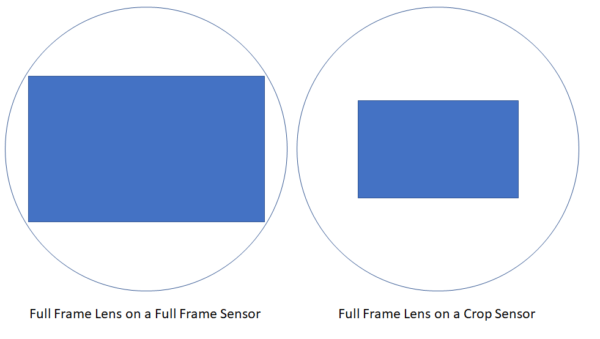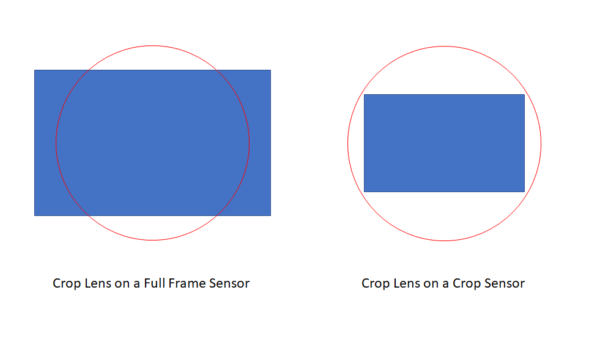Can You Use Full Frame Lenses With Aps-c Cameras Canon
Concluding Updated on Nov 27, 2021 by Jeremy
Disclaimers: Our site uses demographic data, email opt-ins, display advertizing, and affiliate links. Delight check out our Terms and Conditions for more data. Listed prices and allure details may accept changed since our visit and initial publication.
In that location is a lot of confusion on the performance difference between lenses if used on a specific camera trunk, particularly with regards to using total frame lenses on crop sensor cameras (like the Sony a6000, my photographic camera, which uses a "crop" APS-C sensor).
Cameras like mine accept lenses designed for crop sensors (naturally), but also take lenses that are rated for full frame cameras (like the Sony a7iii).
The confusion comes in to play in what kind of image these ii lenses will produce at comparable focal lengths, as the discussion of camera "crop factors" is oftentimes used interchangebly with lenses as much as they are for sensors. Even I accept to acknowledge being messed up on it for quite some time (hence this post).
If comparing a full frame rated lens with a crop sensor lens on the same crop sensor camera body, the main difference is this: nothing.
Focal Length is Focal Length

To put it bluntly- if you lot are looking to buy a full frame rated lens to employ on your crop sensor camera, as long as it is compatible for your brand and mountain, the full frame lens will have the exact same photo as a crop sensor lens insofar as the focal length, aperture, lighting, etc. are all the same.
To translate, a photo taken on a crop sensor Sony a6000 at 24mm f/4.0 one/200 sec with a full frame designed lens volition produce more than-or-less exactly the same photograph as a photo at 24mm f/iv.0 1/200 sec on a lens designed for the crop sensor.
The crop gene means nothing if y'all're only looking at using a total frame rated lens on a crop trunk.
I tested this out, and the results are below for my 18-135mm f/iii.5 lens designed for a crop sensor camera and my 24-240mm f/iii.five lens designed for a full frame camera- both used on the Sony a6000 with the APS-C crop sensor at 24mm:


Can yous tell the difference? No, you lot can't.
This is because a shot at 24mm on a full frame lens and a shot at 24mm on a crop sensor lens will produce exactly the same image if used on the same camera body (my Sony a6000).
You simply don't get a ingather when using full frame lenses on a crop sensor body. The focal length of any lens will produce the aforementioned image on your crop sensor camera regardless of if the lens is designed for a total frame camera or a crop sensor camera.
When the crop gene does come in to play is with regards to the sensor, and it should but be used when comparing camera bodies in addition to the lenses.
The Paradigm Produced Varies By Photographic camera Trunk

The crop factor concept comes in to play when comparison lenses on specific photographic camera bodies. The reason for this is that full frame sensors are physically larger.
This means they often have more pixels, but it also ways that they inherently produce a larger/wider epitome due to the increased area.
If you take a photo at 24mm in focal length on a full frame photographic camera, you're going to become a wider image than a 24mm image on a crop sensor camera. This has zippo to do with the lens (24mm is 24mm), but is all about the size of the image captured on the sensor.
This is where crop factors come up in to play.
My Sony a6000 has an APS-C sensor with a ingather factor of one.5. A 24mm rated photo on my camera captures a scene proportional to what the camera'south sensor allows. Total frame cameras, on the other paw, can capture a larger scene due to the larger sensor size. What they capture at 24mm is actually a lot more of the scene (or, if keeping information technology in camera vernacular, 'wider').
How practise we summate the departure? With ingather factors. The i.five ingather gene rating is how we convert.
Then allow'south say you take an image on my Sony a6000 at 24mm. To recreate that exact same photograph on a full frame camera (framed at the verbal calibration), you'll need to take a photo at 36mm. The reason beingness that the larger sensor collects more of a scene than on a ingather sensor, and then you'll need to shoot at a larger focal length to fill in the same area.
But why the confusion? I feel like a lot of people call back that the rating on the lens ways the ingather cistron is practical when using full frame lenses on a ingather body. It doesn't.
The factor merely comes in to play when you desire to brand an apples-to-apples comparison on cameras in terms of the images actually shot.
Say I want to upgrade my photographic camera in the future from a ingather sensor to a full frame sensor, and I like what the viewing area is at 20mm for my shooting style (broad vistas).
Using a 20mm lens on a full frame camera will actually produce a much wider image (by a gene of 1.v), so instead I should wait at a lens with 30mm instead to get the same verbal result in the frame. (Or in opposite, if a lens review shows a moving-picture show from a full frame torso at xxx mm, and I wanted to recreate information technology at the verbal same spot with my crop sensor, I'd shoot at 20mm).
That is all! The lens sees what the lens sees, and it is the sensor that records the image.
You May Non Exist Able to Use Crop Lenses on Full Frame Cameras
There is one caveat to all of this I experience compelled to mention, and that is in regards to usability.
In the above discussion, I mentioned the physical size of the sensors and how that relates to the crop factor in a torso-to-body discussion.
I mentioned that you can use full frame rated lenses on crop sensor bodies (if compatible for make and mount, of course), but I did not really explicate why that is (and why the reverse is not inherently true).

Full frame rated lenses are often much larger than those designed for crop cameras as they have to let in more calorie-free (by cross-sectional area) to produce images on the larger sensor. These tin can be used on crop sensor cameras considering the lens is larger than what the ingather sensor needs.
The merely negative is the lens is probable going to be bulkier, heavier, and probable more expensive than those designed purely for crop cameras (only sometimes yous take what you can get if its the best fit for you).

On the flip side, however, you ofttimes cannot use a ingather sensor lens on a total frame photographic camera for the very same reason. These lenses are designed to be smaller to let in just enough light to cover a crop sensor and produce an image.
When put on a bigger camera the light will not accomplish the edges of the full frame sensor and produce some distortions on the image.
Some full frame cameras are now able to adjust for this via internal processing, simply they ofttimes simply crop the paradigm to reduce the resolution of the photo to fit the exposed parts of the sensor (per the image to a higher place). But this is not necessarily the case with all cameras, so its best to avert the effect altogether and only buy properly rated lenses (when in doubt, reviews on Amazon provide actually good insight).
This is why you tin utilize full frame rated lenses on crop cameras, but tin can't in contrary. And hopefully with the to a higher place caption, yous at present understand the divergence into how images will expect when using the two kinds of lenses on your ingather sensor body itself.
Just call back:
- Focal length is focal length. A 24mm shot volition always look the same regardless of the lens blazon if used on the aforementioned body.
- Where the image will look unlike is comparing a photo shot at 24mm on a crop sensor camera vs at 24 mm on a full frame camera, and this is due to the sensor size- not the lens.
- You tin can use both kinds of lenses on your crop sensor photographic camera, simply you may not be able to use a lens rated for a crop sensor on a full frame camera unless the camera can internally recoup for this. Newer full-frame cameras tin can digitally crop images to compensate via internal settings, only yous'll exist taking photos at lower MP ratings.
- Camera manufacturer (Sony) and mounting type (E-Mountain, A-Mount) considerations withal apply. Nikon lenses won't piece of work on Sony and A-Mount lenses wont work on East-Mount cameras without adapters (that oft ho-hum functioning).
Fix? Pick up your new camera lens and go shoot!
For frequently asked questions regarding photographic camera sensors, check out the following.
What is the difference between full frame and APS-C sensors?
The difference between full frame and APS-C sensors is their size. The measurement between any two sensors is known every bit the crop cistron. Full frame to APS-C is generally 1.5x (i.e., the full frame sensor is i.5x larger).
How does the sensor relate to the camera lens?
For any given sensor, a proportional lens area is required to capture a scene. For larger sensors, more glass is needed to let calorie-free in to cover the sensor.
Tin can APS-C rated lenses exist used on full frame cameras?
Generally speaking, no. The glass in most APS-C rated lenses is not big enough to let plenty light in to cover the entire sensor on a full frame camera. Some high-end full frame cameras have an internal crop manner, just this is merely a reduction of usable sensor infinite (MP).
Can full frame lenses exist used on APS-C sensors?
More often than not speaking, aye- insofar as the mount is compatible. The glass in most full frame lenses is oversized compared to what is necessary for APS-C sensors, so every bit long as they are uniform with model and mount style it should work. But information technology should exist noted that total frame lenses are often much more than expensive due to this extra glass.
How does image quality compare between the sensors?
Full frame sensors are larger than APS-C sensors, then for an equivalent focal length, the image volition appear much larger (wider) than its APS-C counterparts. A 35mm focal point on a full frame sensor will appear 1.5x larger than a 35mm focal betoken on an APS-C sensor- this is the crop cistron.
Does epitome size change using a total frame lens on an APS-C torso?
The respective paradigm "size" is ever tied to the sensor. If y'all are comparing two lenses on an APS-C trunk, the focal length will always capture the same sized image. If you lot are comparison ane lens used on a total frame sensor and an APS-C sensor, the ingather factor tells how much the apparent paradigm size will change. The sensor should always exist the reference point.
Have an existing weblog that is in need of an upgrade? Cheque out the post-obit services we personally employ!
- BigScoots - Premium managed hosting with plans every bit low as $35/month.
- GeneratePress - A customizable theme designed for site speed.
- AdInserter Pro - A widget logic plugin that is quite powerful.
- WP Rocket - An epitome and caching optimization plug-in.
- Mailerlite - Cost effective newsletter service.
- Keysearch - Keyword research tool for SEO.
- Pretty Links Pro - A nifty link cloaking tool to clean up affiliate links.
Looking for tips? Read our Blog Your Trip serial!
Join Our Newsletter
About Jeremy

About the Writer: Jeremy is a total-time travel writer based in Pittsburgh and primary writer of this site. He has been to lxx+ countries on 5 continents and seeks out new food, run a risk activities, and off-the-beaten-path experiences wherever he travels.
Source: https://www.livingthedreamrtw.com/full-frame-lens-on-crop-sensor
Posted by: berryexisparbace.blogspot.com


0 Response to "Can You Use Full Frame Lenses With Aps-c Cameras Canon"
Post a Comment